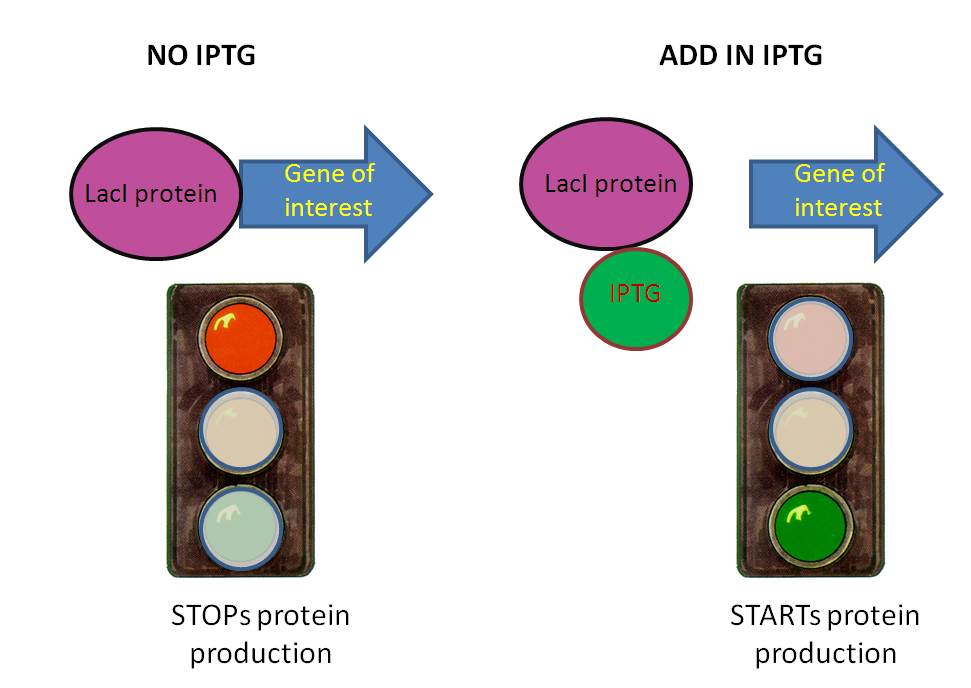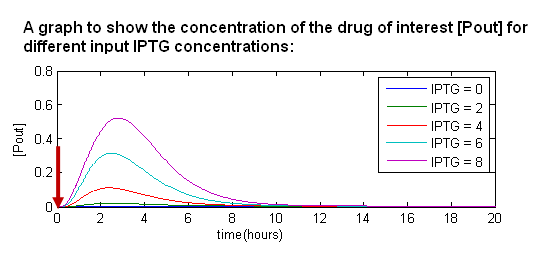Team:Imperial College London/Drylab/Protein Production
From 2009.igem.org
(→Conclusions) |
(→Summary of simulation results) |
||
| (22 intermediate revisions not shown) | |||
| Line 3: | Line 3: | ||
{{Imperial/09/Tabs/M1/Modelling}} | {{Imperial/09/Tabs/M1/Modelling}} | ||
<font face='Calibri' size='5'><b>Protein Production</b></font><br><br> | <font face='Calibri' size='5'><b>Protein Production</b></font><br><br> | ||
| - | Based on the | + | Based on the module 1 genetic circuit, a LacI-IPTG inducible promoter is responsible for kickstarting the production of the drug. |
* In the absence of IPTG, LacI represses the production of the drug (Cellulase or PAH) | * In the absence of IPTG, LacI represses the production of the drug (Cellulase or PAH) | ||
* When IPTG is introduced, the LacI repressing pathway is “de-repressed”, and some output protein is produced. | * When IPTG is introduced, the LacI repressing pathway is “de-repressed”, and some output protein is produced. | ||
| Line 19: | Line 19: | ||
| - | This module is an integral part of the design, as large-scale commercialization of the drug of interest depends on finding the optimal conditions for protein production. | + | This module is an integral part of the design, as large-scale commercialization of the drug of interest depends on finding the optimal conditions for protein production. We implemented a system of differential equations, having made some assumptions and predictions about how the system will behave. |
| + | |||
| + | <html><a href="https://2009.igem.org/Team:Imperial_College_London/Drylab/Protein_production/Analysis"><img style="vertical-align:bottom;" width=50px align="left" src="http://i691.photobucket.com/albums/vv271/dk806/II09_Learnmore.png"></a></html> <b><i>About the model assumptions and predictions! | ||
| + | </i></b><br><br> | ||
| - | |||
| - | |||
| - | |||
| - | |||
===The System=== | ===The System=== | ||
| - | + | [[Image:m1gci.jpg | 600px]]<br> | |
| - | <html><a href="https://2009.igem.org/Team:Imperial_College_London/Drylab/M1/Protein_production/Analysis/Detailed"><img style="vertical-align:bottom;" width= | + | Genetic circuits can be simplified using ODEs. A good introduction to modelling of genetic circuits is provided in [3]. By clicking on the link below we can see how genetic circuits were implemented in this system. <br> |
| - | < | + | |
| - | <br> | + | <html><a href="https://2009.igem.org/Team:Imperial_College_London/Drylab/M1/Protein_production/Analysis/Detailed"><img style="vertical-align:bottom;" width=50px align="left" src="http://i691.photobucket.com/albums/vv271/dk806/II09_Learnmore.png"></a></html> <b><i>about the equations and what they mean! |
| - | <br> | + | </i></b><br><br> |
===Summary of simulation results=== | ===Summary of simulation results=== | ||
*When we introduce IPTG into the system, it temporarily removes LacI from the system. Hence, during this period of time, we produce the drug of interest. | *When we introduce IPTG into the system, it temporarily removes LacI from the system. Hence, during this period of time, we produce the drug of interest. | ||
| Line 36: | Line 35: | ||
*The more IPTG we add in, the higher the amount of output protein. | *The more IPTG we add in, the higher the amount of output protein. | ||
[[Image:II09_SIm_main_prot.jpg]]<br><br> | [[Image:II09_SIm_main_prot.jpg]]<br><br> | ||
| - | <html><a href="https://2009.igem.org/Team:Imperial_College_London/Drylab | + | |
| - | *The effects of IPTG toxicity were investigated and we found that for these concentration ranges, IPTG is not toxic to cells. Click on the link to see the analyzed results:[ | + | <html><a href="https://2009.igem.org/Team:Imperial_College_London/Drylab/Protein_production/Simulations"><img style="vertical-align:bottom;" width=50px align="left" src="http://i691.photobucket.com/albums/vv271/dk806/II09_Learnmore.png"></a></html> <b><i>about the simulations! |
| - | *The constants in this model are arbitrary. We justify our usage of these values with a more detailed dynamical analysis of the system, which shows that it can only have fixed points[1]. [[Media:II09_Prot_stability analysis. | + | </i></b><br><br> |
| + | |||
| + | *The effects of IPTG toxicity were investigated and we found that for these concentration ranges, IPTG is not toxic to cells. Click on the link to see the analyzed results:See [https://2009.igem.org/Team:Imperial_College_London/Wetlab/Results/Cheminduction/IPTG IPTG growth curves] | ||
| + | *The constants in this model are arbitrary. We justify our usage of these values with a more detailed dynamical analysis of the system, which shows that it can only have fixed points[1]. [[Media:II09_Prot_stability analysis.pdf | System stability analysis (read about the equations before opening this file, it's intimidating!)]] | ||
===Conclusions=== | ===Conclusions=== | ||
| Line 44: | Line 46: | ||
*The greater the strength of the Lac promoter, the greater the repressive action of LacI prior IPTG induction. | *The greater the strength of the Lac promoter, the greater the repressive action of LacI prior IPTG induction. | ||
*The greater the Lac promoter leakiness (k<sub>leak</sub>) the greater the basal amount of expression of protein of interest, prior IPTG induction. | *The greater the Lac promoter leakiness (k<sub>leak</sub>) the greater the basal amount of expression of protein of interest, prior IPTG induction. | ||
| - | *The greater the amount of IPTG introduced, the greater the | + | *The greater the amount of IPTG introduced, the greater the production of protein of interest. |
*Here we assumed that the range of IPTG we have introduced is non-toxic for our cells. Growth curves will tell us whether IPTG does limit cell growth at the ranges we are interested in. | *Here we assumed that the range of IPTG we have introduced is non-toxic for our cells. Growth curves will tell us whether IPTG does limit cell growth at the ranges we are interested in. | ||
| + | ===References=== | ||
[1]Steven H. Strogatz (1994). Nonlinear dynamics and chaos: with applications to physics, biology chemistry and engineering. Addison Wesley. ISBN 0-201-54344-3<br> | [1]Steven H. Strogatz (1994). Nonlinear dynamics and chaos: with applications to physics, biology chemistry and engineering. Addison Wesley. ISBN 0-201-54344-3<br> | ||
| - | [2]3.Kuhlman T, Zhang Z, Saier MH Jr, & Hwa T (2007) Combinatorial transcriptional control of the lactose operon of Escherichia coli. - PNAS 104 (14) 6043-6048 | + | [2]3.Kuhlman T, Zhang Z, Saier MH Jr, & Hwa T (2007) Combinatorial transcriptional control of the lactose operon of Escherichia coli. - PNAS 104 (14) 6043-6048 <br> |
| + | [3]2.Alon, U (2006) An Introduction to Systems Biology: Design Principles of Biological Circuits - Chapman & Hall/Crc Mathematical and Computational Biology | ||
| + | |||
| + | <html><center><a href="https://2009.igem.org/Team:Imperial_College_London/Drylab/Autoinduction"><img style="vertical-align:bottom;" width="20%" src="http://i691.photobucket.com/albums/vv271/dk806/II09_Drylabmainimage1.png"></a><a href="https://2009.igem.org/Team:Imperial_College_London/Drylab/Protein_Production"><img style="vertical-align:bottom;" width="20%" src="http://i691.photobucket.com/albums/vv271/dk806/II09_Drylabmainimage2.png"></a><a href="https://2009.igem.org/Team:Imperial_College_London/Drylab/Enzyme"><img style="vertical-align:bottom;" width="20%" src="http://i691.photobucket.com/albums/vv271/dk806/II09_Drylabmainimage3.png"></a> | ||
| + | <a href="https://2009.igem.org/Team:Imperial_College_London/Drylab/Genome_deletion"><img style="vertical-align:bottom;" width="20%" src="http://i691.photobucket.com/albums/vv271/dk806/II09_Drylabmainimage5.png"></a></center></html> | ||
| + | |||
| + | <html><table border="0" style="background-color:transparent;" width="100%"> | ||
| + | <tr><td width="0%"> </td> | ||
| + | <td width="22%"><center><a href="https://2009.igem.org/Team:Imperial_College_London/Drylab/Autoinduction"><b>Autoinduction</b></a></center></td> | ||
| + | <td width="22%"><center><a href="https://2009.igem.org/Team:Imperial_College_London/Drylab/Protein_Production"><b>Protein Production</b></a></center></td> | ||
| + | <td width="22%"><left><a href="https://2009.igem.org/Team:Imperial_College_London/Drylab/Enzyme"><b>Drug Kinetics</b></a></left></td> | ||
| + | <td width="22%"><left><a href="https://2009.igem.org/Team:Imperial_College_London/Drylab/Genome_deletion"><b>Genome Deletion</b></a></left></td> | ||
| + | <td width="1%"></td> | ||
| + | </tr></table></html> | ||
| + | <br> | ||
<!-- | <!-- | ||
{{Imperial/Box1|Module 1: Protein production|Two models are required to explain the functionality of M1: | {{Imperial/Box1|Module 1: Protein production|Two models are required to explain the functionality of M1: | ||
Latest revision as of 23:53, 13 October 2009

- Overview
- The model
- Simulations
Protein Production
Based on the module 1 genetic circuit, a LacI-IPTG inducible promoter is responsible for kickstarting the production of the drug.
- In the absence of IPTG, LacI represses the production of the drug (Cellulase or PAH)
- When IPTG is introduced, the LacI repressing pathway is “de-repressed”, and some output protein is produced.
Contents |
Our goals
The modelling aims to provide an overview and better understanding of the M1 system’s function by:
- Characterizing the system.
- Modeling to account for several factors that may reduce/hinder the production of the protein drug such as:
- Lac promoter leakiness
- IPTG toxicity
- Stability of output protein
This module is an integral part of the design, as large-scale commercialization of the drug of interest depends on finding the optimal conditions for protein production. We implemented a system of differential equations, having made some assumptions and predictions about how the system will behave.
 About the model assumptions and predictions!
About the model assumptions and predictions!
The System

Genetic circuits can be simplified using ODEs. A good introduction to modelling of genetic circuits is provided in [3]. By clicking on the link below we can see how genetic circuits were implemented in this system.
 about the equations and what they mean!
about the equations and what they mean!
Summary of simulation results
- When we introduce IPTG into the system, it temporarily removes LacI from the system. Hence, during this period of time, we produce the drug of interest.
- When the effects of IPTG wear off, the system returns to equilibrium.
- The more IPTG we add in, the higher the amount of output protein.
- The effects of IPTG toxicity were investigated and we found that for these concentration ranges, IPTG is not toxic to cells. Click on the link to see the analyzed results:See IPTG growth curves
- The constants in this model are arbitrary. We justify our usage of these values with a more detailed dynamical analysis of the system, which shows that it can only have fixed points[1]. System stability analysis (read about the equations before opening this file, it's intimidating!)
Conclusions
NOTE: These will be better understood once the reader has gone through the details ("Learn More").
- The greater the strength of the Lac promoter, the greater the repressive action of LacI prior IPTG induction.
- The greater the Lac promoter leakiness (kleak) the greater the basal amount of expression of protein of interest, prior IPTG induction.
- The greater the amount of IPTG introduced, the greater the production of protein of interest.
- Here we assumed that the range of IPTG we have introduced is non-toxic for our cells. Growth curves will tell us whether IPTG does limit cell growth at the ranges we are interested in.
References
[1]Steven H. Strogatz (1994). Nonlinear dynamics and chaos: with applications to physics, biology chemistry and engineering. Addison Wesley. ISBN 0-201-54344-3
[2]3.Kuhlman T, Zhang Z, Saier MH Jr, & Hwa T (2007) Combinatorial transcriptional control of the lactose operon of Escherichia coli. - PNAS 104 (14) 6043-6048
[3]2.Alon, U (2006) An Introduction to Systems Biology: Design Principles of Biological Circuits - Chapman & Hall/Crc Mathematical and Computational Biology




 "
"





